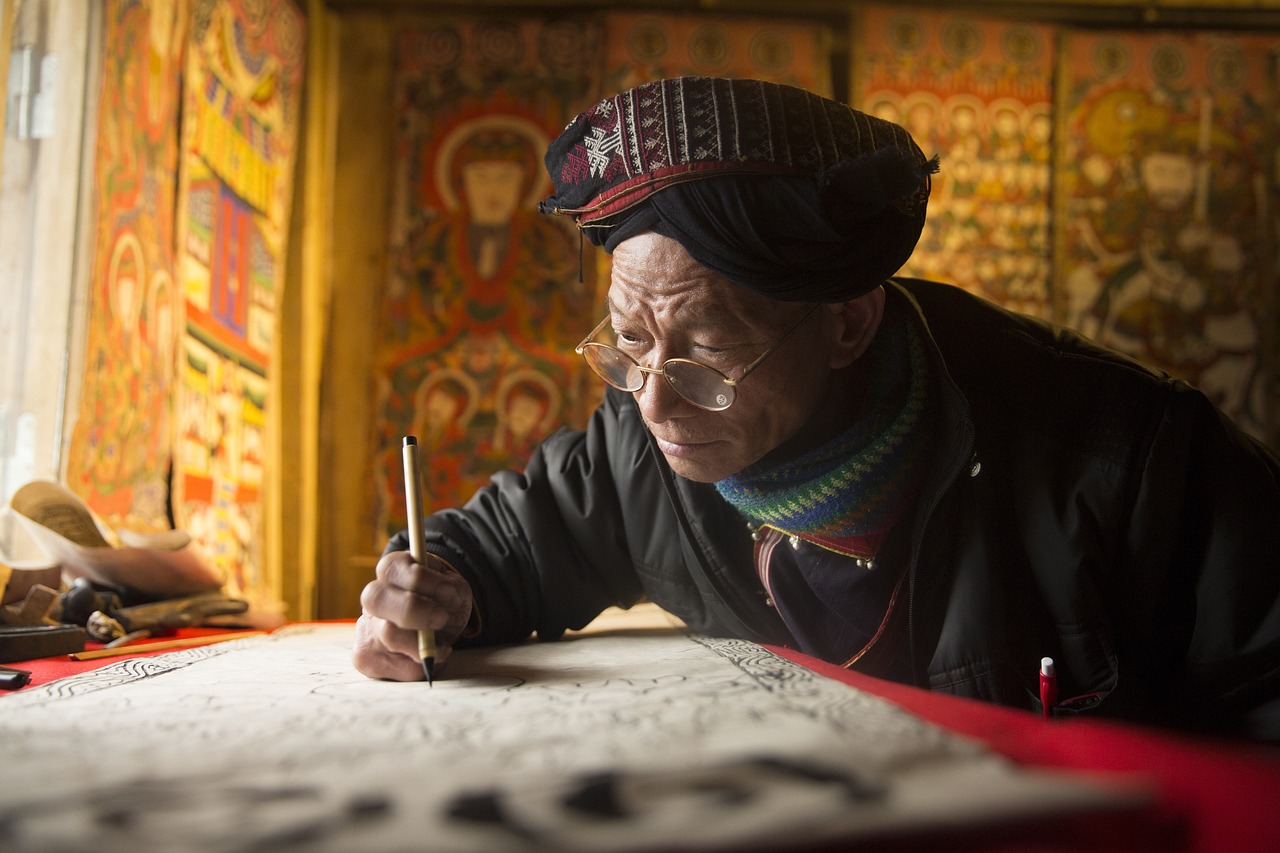How to Use Cultural Narratives in Research Design
In today's increasingly diverse world, understanding the perspectives and experiences of different communities is more crucial than ever. One of the most effective ways to achieve this is by integrating cultural narratives into research design. These narratives, which encapsulate the stories, beliefs, and practices of a community, serve as a lens through which researchers can gain deeper insights into the lived experiences of their participants. By weaving cultural narratives into the fabric of research, we not only enhance the richness of our data but also foster a sense of inclusivity and respect for the communities we study.
Imagine embarking on a journey where every step is guided by the stories of those who walked the path before you. This is the essence of utilizing cultural narratives in research. They provide context and depth, allowing researchers to interpret data through a more comprehensive and empathetic lens. Without these narratives, research can often feel like a puzzle missing its most vital pieces. By embracing cultural narratives, researchers can transform their studies into narratives that resonate and reflect the true essence of the communities involved.
Moreover, cultural narratives are not just about collecting stories; they are about engaging with participants in a meaningful way. When researchers actively listen to and incorporate these narratives, they validate the experiences of their subjects, fostering a collaborative atmosphere that enhances trust and openness. This approach not only enriches the research findings but also empowers participants, giving them a voice and a stake in the research process.
As we delve deeper into the methodologies and practical applications of cultural narratives in research design, it becomes evident that this approach is not merely an option but a necessity for effective and ethical research. By prioritizing cultural narratives, we can create research that is not only informative but also transformative, paving the way for a more inclusive and understanding society.
Cultural narratives provide context and depth to research, enriching data interpretation and fostering a more comprehensive understanding of participants' experiences and perspectives. When researchers engage with these narratives, they are not just collecting data; they are tapping into the very essence of what makes a community unique. This approach allows for a richer, more nuanced interpretation of research findings, ultimately leading to better outcomes and more impactful results.
Cultural narratives encompass the stories, beliefs, and practices that shape a community's identity. They are the threads that weave together the fabric of a culture, providing insight into its values, norms, and historical contexts. Understanding these narratives is crucial for effective research design and interpretation. By recognizing the significance of cultural narratives, researchers can craft studies that are not only relevant but also respectful of the communities they aim to represent.
Different types of cultural narratives exist, each offering unique insights and perspectives relevant to research. These can be categorized into three primary types:
- Oral Traditions: Powerful means of transmitting cultural knowledge and values.
- Written Histories: Document cultural narratives through literature and historical accounts.
- Digital Stories: Utilize modern technology to convey cultural narratives and engage diverse audiences.
Integrating cultural narratives into research design involves careful consideration of methodology, participant engagement, and ethical considerations to ensure authenticity and respect. This process requires researchers to be open-minded and flexible, adapting their approaches to fit the unique cultural contexts of their participants.
Various methodological approaches, such as narrative inquiry and participatory research, can effectively incorporate cultural narratives. These methods foster collaboration and deeper understanding, allowing researchers to work alongside participants rather than merely observing them. This collaborative spirit can lead to richer data and a more profound connection between researchers and communities.
Ethical considerations are paramount when using cultural narratives. Researchers must be sensitive to cultural contexts and the potential impact on communities involved in the research. This means obtaining informed consent, being transparent about research intentions, and ensuring that the narratives shared are treated with the utmost respect and confidentiality.
Examining case studies where cultural narratives have been successfully integrated into research design can provide valuable insights and best practices for future studies. These examples not only highlight the effectiveness of this approach but also serve as a guide for researchers looking to enhance their own work.
Q: What are cultural narratives?
A: Cultural narratives are the stories, beliefs, and practices that shape the identity of a community. They provide context and depth to research, allowing for a better understanding of participants' experiences.
Q: Why are cultural narratives important in research?
A: They enrich data interpretation, foster inclusivity, and enhance the overall quality of research by providing a more comprehensive understanding of the communities being studied.
Q: How can I incorporate cultural narratives into my research design?
A: Consider using methodologies such as narrative inquiry or participatory research, which emphasize collaboration and engagement with participants. Always prioritize ethical considerations and respect for cultural contexts.

The Importance of Cultural Narratives
Cultural narratives are more than just stories; they are the lifeblood of communities, weaving together the threads of history, identity, and values. When we dive into research, understanding these narratives is like opening a treasure chest filled with insights that can transform our findings. Imagine trying to understand a painting without knowing the artist’s background—cultural narratives provide that essential context, enabling researchers to interpret data more profoundly and meaningfully.
At their core, cultural narratives help us to comprehend the complexity of human experiences. They allow researchers to step into the shoes of participants, to see the world through their eyes. This is crucial, especially in fields like anthropology, sociology, and psychology, where the goal is to grasp the nuances of human behavior and social interactions. By integrating cultural narratives into research design, we not only enrich our data but also foster a more inclusive approach that respects and honors the voices of diverse communities.
Furthermore, cultural narratives can illuminate patterns and themes that might otherwise go unnoticed. For instance, consider a study focused on health disparities within a community. By incorporating narratives from local residents, researchers can uncover underlying beliefs about health practices, access to care, and the impact of socio-economic factors. This deeper understanding can lead to more effective interventions and policies that resonate with the community's unique context.
Incorporating cultural narratives also promotes collaboration between researchers and communities. When researchers acknowledge and value the stories of participants, it fosters trust and encourages more open dialogue. This collaborative spirit can lead to richer data collection and a more respectful research environment. As researchers, we must ask ourselves: Are we merely observers, or are we co-creators of knowledge? By embracing cultural narratives, we can transition into the latter role, enhancing both our work and the communities we study.
In summary, the importance of cultural narratives in research design cannot be overstated. They provide essential context, foster inclusivity, reveal hidden patterns, and promote collaboration. As we move forward in our research endeavors, let us remember that every narrative holds a piece of the puzzle, and it is our duty to listen, learn, and integrate these stories into our work.

Defining Cultural Narratives
Cultural narratives are the vibrant stories, beliefs, and practices that weave together the tapestry of a community's identity. They are not just tales spun from imagination; they are the very essence of who we are, reflecting our values, experiences, and the worldviews that shape our lives. Imagine standing in a bustling market, the air thick with the scent of spices and the sound of laughter. Each interaction, every whispered story, contributes to a larger narrative that defines that community. Understanding these narratives is crucial for effective research design and interpretation, as they provide a lens through which researchers can view the complexities of human experience.
At their core, cultural narratives serve as a bridge connecting researchers to participants. They offer insights into how individuals and communities perceive themselves and their place in the world. By delving into these narratives, researchers can uncover layers of meaning that might otherwise remain hidden. For instance, when studying a community affected by environmental changes, understanding their cultural narratives about nature can reveal how they relate to their environment, influencing their responses to research questions.
Moreover, cultural narratives can take many forms, each contributing uniquely to the understanding of a community's identity. They can be expressed through:
- Oral Traditions: These are the spoken stories passed down through generations, often rich with cultural wisdom.
- Written Histories: Documented narratives found in books, articles, and archives that provide a structured account of cultural experiences.
- Digital Stories: Contemporary expressions of culture shared through social media, videos, and online platforms, making them accessible to a broader audience.
Incorporating these diverse forms of cultural narratives into research design not only enhances the richness of data collection but also promotes inclusivity. It acknowledges the voices of participants, ensuring that their stories are heard and valued. By recognizing the significance of cultural narratives, researchers can create a more holistic approach to understanding the complexities of human behavior and societal structures.
- What are cultural narratives? Cultural narratives are the stories, beliefs, and practices that shape a community's identity and influence how individuals perceive their world.
- Why are cultural narratives important in research? They provide context and depth, allowing researchers to interpret data more comprehensively and understand participants' experiences.
- How can researchers incorporate cultural narratives into their studies? By utilizing methodologies like narrative inquiry and participatory research, researchers can engage with cultural narratives effectively.
- What ethical considerations should be taken into account? Researchers must be sensitive to cultural contexts and the potential impact of their work on the communities involved.

Types of Cultural Narratives
Cultural narratives come in various forms, each offering a unique lens through which to understand the complexities of human experience. These narratives are not just stories; they are the fabric that weaves together the beliefs, values, and identities of a community. By recognizing the different types of cultural narratives, researchers can better appreciate the richness of the data they collect and the stories they seek to tell. Let’s dive into some of the most prominent types of cultural narratives that researchers can utilize.
One of the most traditional forms of cultural narratives is oral traditions. These are the stories passed down through generations, often through spoken word. They serve as a powerful means of transmitting cultural knowledge and values. Oral traditions can include myths, legends, folktales, and proverbs that encapsulate the wisdom of a community. They are not just entertaining tales; they carry profound meanings and teachings that reflect the community's history and beliefs. For example, a community may use oral narratives to teach younger generations about their ancestry, moral values, and social norms.
Moving beyond oral traditions, we encounter written histories. These narratives are documented through various mediums such as literature, historical texts, and academic research. Written histories provide a structured approach to analyzing cultural contexts, allowing researchers to delve into the documented experiences of a community. They often serve as a crucial resource for understanding how historical events have shaped the present cultural landscape. For instance, a researcher might analyze a collection of letters from a historical figure to gain insight into the societal norms of that era.
In our digital age, we cannot overlook the significance of digital stories. These narratives utilize modern technology to convey cultural expressions in innovative ways. Digital stories can be found on platforms like social media, blogs, and video-sharing sites, providing an accessible means for individuals to share their experiences and perspectives. This form of narrative is particularly valuable as it allows for a diverse range of voices to be heard, often from marginalized groups who may not have had the opportunity to share their stories through traditional means. By engaging with digital narratives, researchers can tap into contemporary cultural expressions that reflect the current state of society.
To summarize, the types of cultural narratives—oral traditions, written histories, and digital stories—each provide unique insights that enrich research design. By incorporating these narratives into their methodologies, researchers can foster a deeper understanding of the communities they study. This not only enhances the quality of the research but also ensures that the voices of participants are honored and represented authentically. Understanding these diverse forms of cultural narratives is essential for any researcher aiming to create a more inclusive and comprehensive study.
- What are cultural narratives? Cultural narratives are the stories, beliefs, and practices that shape a community's identity and provide context for understanding their experiences.
- Why are oral traditions important in research? Oral traditions preserve cultural knowledge and values, offering insights into community histories and experiences that may not be documented elsewhere.
- How can digital stories enhance research? Digital stories allow researchers to engage with contemporary cultural expressions and reach diverse audiences, capturing voices that might be overlooked in traditional narratives.
- What ethical considerations should be taken into account when using cultural narratives? Researchers must be sensitive to cultural contexts and the potential impact of their work on the communities involved, ensuring respect and authenticity in representation.

Oral Traditions
Oral traditions are more than just stories; they are the lifeblood of cultural identity, passed down through generations like a cherished heirloom. These narratives serve as a vital means of transmitting cultural knowledge and values, often encapsulating the essence of a community's history and experiences. Imagine sitting around a warm fire, surrounded by family and friends, as an elder weaves tales of bravery, love, and hardship. Each story not only entertains but also educates, shaping the collective memory and identity of the group.
The power of oral traditions lies in their ability to connect individuals with their roots, fostering a sense of belonging and continuity. In research, these narratives can provide invaluable insights into the lived experiences of participants, revealing perspectives that quantitative data might overlook. For instance, when studying a community's response to a natural disaster, oral histories can illuminate the emotional and social dynamics at play, offering a more nuanced understanding than statistics alone.
But how do researchers effectively harness these oral traditions? It starts with creating a safe and respectful environment for storytelling. Researchers must approach participants with sensitivity, recognizing the significance of their narratives. This process often involves:
- Building trust with the community
- Obtaining informed consent
- Respecting the cultural significance of stories
Moreover, oral traditions can take many forms, from folktales and myths to personal anecdotes and community histories. Each type carries its own weight and significance. For example, while folktales may convey moral lessons, personal anecdotes can reveal the unique struggles and triumphs of individuals within the community. By documenting these narratives, researchers can create a rich tapestry of cultural expression that enhances the overall understanding of the research subject.
In essence, oral traditions are not merely a method of data collection; they are a gateway to understanding the intricate layers of culture and identity. By valuing and integrating these narratives into research design, scholars can foster a more inclusive and comprehensive approach that honors the voices of the communities they study.
- What are oral traditions? Oral traditions are stories, myths, and histories passed down verbally within a community, often reflecting its values and beliefs.
- Why are oral traditions important in research? They provide deep insights into cultural identity and community experiences, enriching the data collected and enhancing understanding.
- How can researchers ensure ethical practices when using oral traditions? Researchers should build trust, obtain informed consent, and respect the cultural significance of the stories shared.
- What types of oral traditions exist? They include folktales, personal anecdotes, community histories, and more, each offering unique perspectives.

Written Histories
Written histories serve as a crucial framework for understanding cultural narratives, offering a structured means to document and analyze the complexities of human experiences. These histories are not just mere accounts of events; they encapsulate the beliefs, values, and traditions of communities, providing rich contexts that inform research design. By delving into written histories, researchers can uncover layers of meaning that may otherwise remain hidden in oral traditions or contemporary narratives.
One of the most significant advantages of utilizing written histories in research is their ability to present a **chronological account** of events. This timeline helps researchers trace the evolution of cultural practices and beliefs over time, allowing for a more comprehensive understanding of how these factors influence current behaviors and attitudes. Moreover, written histories can be found in various forms, including:
- Literature: Novels, poems, and plays often reflect the cultural narratives of their time, providing insight into societal values and struggles.
- Archives: Historical documents, letters, and photographs can reveal the lived experiences of individuals and communities, allowing researchers to piece together narratives that shape cultural identities.
- Scholarly Works: Academic publications often analyze and interpret cultural narratives, offering critical perspectives that can enhance research methodologies.
Integrating these written sources into research design not only enriches the data but also fosters a deeper connection between researchers and the communities they study. For instance, when researchers reference historical texts, they can draw parallels between past and present, highlighting how historical events continue to influence contemporary issues. This approach not only validates the significance of cultural narratives but also promotes inclusivity by acknowledging diverse voices within the research context.
Furthermore, written histories can serve as a **point of reflection** for researchers, prompting them to consider their own biases and perspectives when interpreting data. By engaging with these narratives, researchers can cultivate a more empathetic understanding of the communities they work with, ultimately leading to more ethical and responsible research practices.
In summary, written histories are indispensable tools in the realm of research design. They provide a structured approach to examining cultural narratives, allowing researchers to uncover the rich tapestry of human experience. By integrating these historical accounts into their work, researchers not only enhance their understanding but also contribute to a more nuanced and inclusive representation of diverse communities.
1. What are cultural narratives?
Cultural narratives are the stories, beliefs, and practices that shape a community's identity. They provide context and depth to research, enriching data interpretation.
2. Why are written histories important in research?
Written histories document cultural narratives and offer a structured approach to analyzing cultural contexts, helping researchers understand the evolution of beliefs and practices over time.
3. How can researchers ethically incorporate cultural narratives into their work?
Researchers should approach cultural narratives with sensitivity and respect, ensuring that they honor the voices and experiences of the communities involved in their research.
4. What types of written histories can be utilized in research?
Researchers can utilize literature, historical documents, and scholarly works to gain insights into cultural narratives and enhance their research design.

Digital Stories
In today's fast-paced digital age, have emerged as a vibrant and dynamic medium for sharing cultural narratives. These narratives utilize technology to convey personal and communal stories, often blending text, images, audio, and video to create a rich tapestry of experiences. Imagine walking through a virtual gallery where each piece tells a story, pulling you in with its emotional depth and cultural significance. That's the power of digital storytelling!
Digital stories are not just about entertainment; they serve as a crucial tool for researchers to engage with diverse audiences and capture contemporary cultural expressions. By using platforms like social media, podcasts, and video-sharing sites, researchers can disseminate their findings in ways that resonate with the public. This approach not only makes the research more accessible but also encourages participants to share their own narratives, creating a dialogue that enriches the research process.
One of the most exciting aspects of digital stories is their ability to transcend geographical boundaries. With just a click, a story can be shared globally, allowing individuals from different backgrounds to connect over shared experiences or learn about cultures vastly different from their own. This interconnectedness fosters a sense of community and understanding that traditional methods often miss. For instance, a digital story about a local festival can be viewed by someone halfway across the world, offering them a glimpse into that culture's values and traditions.
However, integrating digital stories into research design is not without its challenges. Researchers must consider aspects such as ethical storytelling, ensuring that the narratives shared are respectful and accurately represent the subjects' voices. Furthermore, the technology used must be accessible to all participants, as digital divides can hinder participation from marginalized groups. Therefore, it’s essential to approach this medium thoughtfully, balancing creativity with responsibility.
To illustrate the impact of digital stories, consider the following table that highlights key benefits:
| Benefit | Description |
|---|---|
| Accessibility | Digital stories can reach a wider audience through various online platforms. |
| Engagement | Interactive elements can draw viewers in and encourage participation. |
| Cultural Preservation | They help document and share cultural practices that may be at risk of fading. |
| Empowerment | Participants can share their own stories, giving them a voice in the research. |
In conclusion, digital stories represent a fascinating intersection of culture and technology, offering researchers innovative ways to integrate cultural narratives into their work. By embracing this medium, we can not only enhance our understanding of diverse experiences but also promote inclusivity, making research a collaborative and enriching endeavor.
- What are digital stories? Digital stories are narratives that utilize multimedia elements such as text, images, audio, and video to convey personal or cultural experiences.
- How can digital stories enhance research? They can engage wider audiences, facilitate cultural exchange, and provide a platform for participants to share their voices.
- What are the challenges of using digital stories in research? Challenges include ensuring ethical storytelling, addressing technological accessibility, and maintaining authenticity in representation.

Incorporating Cultural Narratives into Research Design
Integrating cultural narratives into research design is not just a trend; it's a necessity for anyone looking to capture the full spectrum of human experience. Imagine embarking on a journey where every twist and turn reveals a rich tapestry of stories that shape communities. By weaving these narratives into the fabric of research, we can create a more inclusive and nuanced understanding of the subjects we study. This process involves a careful blend of methodology, participant engagement, and ethical considerations, ensuring that the voices of the community are not only heard but also respected.
When we think about methodology, the question arises: how do we effectively incorporate these narratives? One approach is through narrative inquiry, which focuses on the stories individuals tell about their lives. This method allows researchers to delve deep into personal experiences, revealing insights that quantitative data alone may overlook. Another effective strategy is participatory research, where researchers collaborate with community members to co-create knowledge. This approach not only empowers participants but also enriches the research with authentic cultural narratives.
Engaging participants in a meaningful way is crucial. It's not enough to simply collect stories; we must foster an environment where participants feel comfortable sharing their experiences. This can be achieved through community workshops, where individuals are invited to share their narratives in a supportive setting. By creating a safe space, researchers can encourage more honest and detailed storytelling, which ultimately enhances the quality of the research.
However, with great power comes great responsibility. Ethical considerations are paramount when incorporating cultural narratives into research design. Researchers must approach these narratives with sensitivity, ensuring that they respect the cultural contexts and histories of the communities involved. This includes obtaining informed consent, being transparent about how the narratives will be used, and considering the potential impact on the community. It's essential to ask ourselves: are we honoring the stories we collect, or are we merely using them as data points? The answer to this question can significantly influence the integrity of the research.
In summary, incorporating cultural narratives into research design is a dynamic process that requires thoughtful planning and execution. By utilizing methodologies like narrative inquiry and participatory research, engaging participants authentically, and adhering to ethical standards, researchers can create a rich, inclusive, and respectful research environment. As we continue to explore this fascinating intersection of culture and research, we open doors to deeper understanding and connection.
- What are cultural narratives? Cultural narratives are the stories, beliefs, and practices that shape a community's identity, providing context to their experiences.
- How can I incorporate cultural narratives into my research? You can use methodologies like narrative inquiry and participatory research, engage with participants authentically, and ensure ethical considerations are met.
- Why are ethical considerations important in this context? Ethical considerations are crucial to respect the cultural contexts and histories of the communities involved, ensuring that their stories are honored and not exploited.

Methodological Approaches
When it comes to integrating cultural narratives into research design, the choice of methodology can significantly influence the depth and authenticity of the findings. Two prominent approaches stand out: narrative inquiry and participatory research. Each of these methodologies offers unique pathways for engaging with cultural narratives, allowing researchers to delve into the rich tapestry of community experiences.
Narrative inquiry is a qualitative research method that focuses on the stories individuals tell about their lives. This approach emphasizes the importance of personal experiences and the meanings that individuals attach to them. By collecting and analyzing these narratives, researchers can uncover the underlying cultural values and beliefs that shape participants' identities. For instance, a narrative inquiry might involve in-depth interviews where participants recount pivotal moments in their lives, revealing how their cultural backgrounds influence their perspectives and decisions. This method not only enriches the data but also fosters a deeper emotional connection between the researcher and the participants.
On the other hand, participatory research actively involves participants in the research process. This methodology is rooted in the belief that those who are being studied should have a voice in shaping the research agenda. By collaborating with community members, researchers can ensure that the cultural narratives being explored are authentic and representative of the community's experiences. For example, in a participatory research project, community members might co-create surveys or focus group discussions, allowing them to highlight the cultural stories they deem important. This approach not only empowers participants but also enhances the validity of the research findings, as the narratives collected are more likely to resonate with the community's lived experiences.
To illustrate these methodologies further, consider the following table that outlines the key differences between narrative inquiry and participatory research:
| Aspect | Narrative Inquiry | Participatory Research |
|---|---|---|
| Focus | Individual stories and personal experiences | Community involvement and co-creation |
| Data Collection | Interviews, personal reflections | Surveys, focus groups, workshops |
| Researcher Role | Active listener and interpreter | Facilitator and collaborator |
| Outcome | Rich, contextual understanding of narratives | Empowered communities and relevant findings |
Ultimately, the choice between these methodological approaches depends on the research goals and the community being studied. While narrative inquiry offers profound insights into individual experiences, participatory research fosters a sense of ownership and empowerment among community members. By thoughtfully selecting and applying these methodologies, researchers can effectively weave cultural narratives into their studies, leading to a more nuanced and inclusive understanding of the subjects at hand.
- What are cultural narratives? Cultural narratives are the stories, beliefs, and practices that define a community's identity and shape its members' experiences.
- Why are cultural narratives important in research? They provide context and depth, enriching data interpretation and fostering a comprehensive understanding of participants' perspectives.
- What is narrative inquiry? Narrative inquiry is a qualitative research method focusing on the stories individuals tell about their lives to uncover cultural values and beliefs.
- What is participatory research? Participatory research involves the active engagement of participants in the research process, ensuring their voices and experiences shape the study.

Ethical Considerations
When we dive into the realm of cultural narratives, ethics play a pivotal role in ensuring that our research is not only effective but also respectful and responsible. Engaging with cultural narratives means stepping into the lives and stories of individuals and communities, which inherently comes with a set of ethical obligations. First and foremost, it's crucial to approach these narratives with a sense of respect and responsibility. Researchers must recognize that these stories are not just data points; they are the lifeblood of communities, filled with emotions, histories, and identities.
One of the primary ethical considerations is obtaining informed consent. This means that participants should fully understand how their narratives will be used and the potential impacts of their participation. Imagine sharing your story, only to find it misrepresented or used in ways you never intended. This is why clear communication is essential. Researchers should provide participants with detailed information about the research purpose, methods, and any potential risks involved.
Moreover, we must be aware of the power dynamics at play. Often, researchers come from different backgrounds than their participants, which can create an imbalance. To mitigate this, employing participatory research methods can be beneficial. These methods allow participants to have a say in how their stories are told and ensure that their voices are amplified rather than overshadowed. It's like inviting someone to the table instead of just taking their food without asking.
Another significant aspect is the potential for cultural appropriation. Researchers must tread carefully to avoid exploiting cultural narratives for personal or academic gain without giving due credit or recognition to the communities involved. This means acknowledging the source of the narratives and ensuring that the communities are not only represented but also compensated for their contributions where applicable. By doing so, we foster a sense of partnership and mutual respect.
Lastly, it is essential to consider the long-term impacts of sharing cultural narratives. Will the dissemination of these stories lead to positive outcomes for the community, or could it inadvertently harm them? Researchers must be proactive in discussing these implications with participants and take steps to safeguard their well-being. It's about creating a collaborative environment where everyone feels safe and valued.
In summary, ethical considerations in incorporating cultural narratives into research design are multifaceted and require a thoughtful approach. By prioritizing respect, informed consent, power dynamics, cultural sensitivity, and long-term impacts, researchers can ensure that their work not only contributes to knowledge but also honors the rich tapestry of human experience.
- What are cultural narratives? Cultural narratives are stories, beliefs, and practices that shape a community's identity and provide context for understanding their experiences.
- Why are ethical considerations important in research? Ethical considerations ensure that research is conducted responsibly, respecting participants' rights, and protecting their identities and stories.
- How can researchers obtain informed consent? Researchers should clearly explain the purpose of the research, how the data will be used, and any potential risks to participants before they agree to participate.
- What is cultural appropriation, and why is it a concern? Cultural appropriation occurs when individuals or groups exploit another culture's narratives or symbols without permission or understanding, often leading to misrepresentation and harm.
- How can researchers ensure the long-term impacts of their work are positive? Researchers should engage with the communities involved, discussing potential implications and working collaboratively to ensure that the outcomes benefit the participants.

Case Studies of Successful Integration
When it comes to integrating cultural narratives into research design, real-world examples can illuminate the path forward. These case studies not only showcase the diverse methodologies employed but also highlight the profound impact that cultural narratives can have on research outcomes. One notable example is the Indigenous Knowledge Project conducted in Australia, where researchers collaborated with Aboriginal communities to document and analyze traditional ecological knowledge. This project utilized oral traditions as a primary data source, allowing the community to share their stories and insights directly. The result was a richer understanding of ecological practices that had been passed down through generations.
Another compelling case study is the Digital Storytelling Initiative in the United States, which focused on capturing the experiences of marginalized communities through digital narratives. Participants were trained to create short videos that represented their cultural backgrounds and personal stories. This approach not only empowered the participants but also provided researchers with a nuanced understanding of the challenges these communities faced. By employing digital storytelling, the research was able to reach a wider audience, fostering greater empathy and awareness.
In both cases, the integration of cultural narratives transformed the research process. The Indigenous Knowledge Project allowed for a collaborative approach where the community's voice was not just heard but actively shaped the research questions and outcomes. Similarly, the Digital Storytelling Initiative emphasized the importance of participant engagement, ensuring that the narratives produced were authentic and reflective of the communities' lived experiences.
These examples highlight key elements that contribute to successful integration:
- Collaboration: Engaging with communities fosters trust and enables researchers to gain deeper insights.
- Empowerment: Allowing participants to share their narratives in their own voices enhances authenticity and relevance.
- Adaptability: Utilizing various formats, from oral traditions to digital stories, allows for a comprehensive understanding of cultural contexts.
Moreover, these case studies serve as a reminder that the integration of cultural narratives is not merely an add-on to research design; it is a fundamental aspect that can redefine the entire research process. By valuing and prioritizing cultural narratives, researchers can create more inclusive, respectful, and impactful studies that resonate with both participants and broader audiences.
Q1: What are cultural narratives?
A1: Cultural narratives are the stories, beliefs, and practices that shape a community's identity and experiences. They provide context and depth to research, enriching data interpretation.
Q2: How can cultural narratives enhance research design?
A2: By integrating cultural narratives, researchers can gain a comprehensive understanding of participants' perspectives, fostering inclusivity and authenticity in the research process.
Q3: What ethical considerations should be taken into account?
A3: Researchers should be sensitive to cultural contexts, ensuring respect for participants and their narratives, and be mindful of the potential impact of their research on the communities involved.
Q4: Can you provide examples of methodologies that incorporate cultural narratives?
A4: Methodologies such as narrative inquiry and participatory research are effective in incorporating cultural narratives, allowing for collaboration and deeper understanding between researchers and participants.
Frequently Asked Questions
- What are cultural narratives?
Cultural narratives are the stories, beliefs, and practices that define a community's identity. They encompass everything from oral traditions to written histories and digital stories, providing a rich tapestry of context that enhances research understanding.
- Why are cultural narratives important in research design?
Cultural narratives add depth and context to research, allowing for a more nuanced interpretation of data. They help researchers to understand participants' experiences and perspectives, making the research more inclusive and relevant.
- How can I incorporate cultural narratives into my research?
To incorporate cultural narratives, consider using methodologies like narrative inquiry or participatory research. Engage with participants meaningfully and ensure that you are sensitive to the cultural contexts involved.
- What are some examples of methodological approaches for integrating cultural narratives?
Some effective methodological approaches include narrative inquiry, which focuses on personal stories, and participatory research, which involves participants in the research process. Both methods foster collaboration and deeper understanding.
- What ethical considerations should I keep in mind?
Ethical considerations are crucial when using cultural narratives. It's important to be sensitive to cultural contexts and consider the potential impact of your research on the communities involved. Always strive to respect their stories and experiences.
- Can you provide examples of successful integration of cultural narratives in research?
Yes! Examining case studies where cultural narratives have been successfully integrated can reveal valuable insights and best practices. These examples can guide future research efforts and demonstrate the positive impact of including cultural perspectives.
- What types of cultural narratives are most commonly used in research?
Common types of cultural narratives include oral traditions, which transmit knowledge through storytelling; written histories, which document cultural narratives in literature and archives; and digital stories, which use modern technology to convey cultural expressions.



















